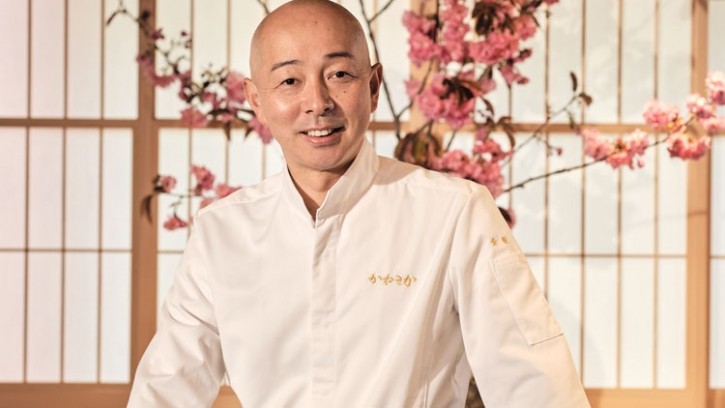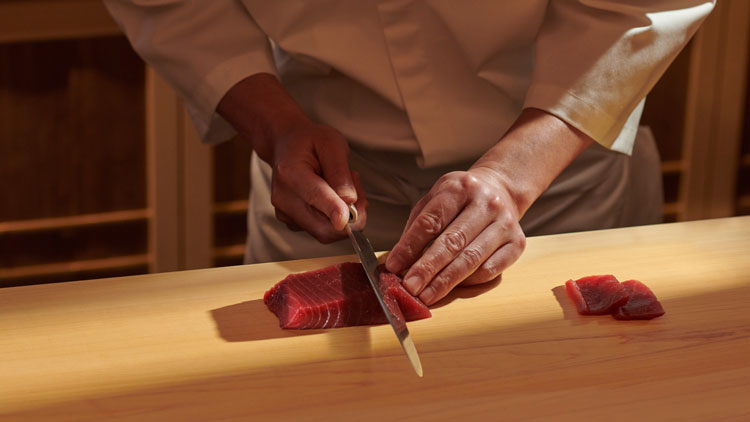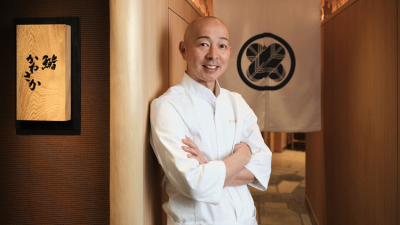Shinji Kanesaka: "I still consider myself a student, the customer is my teacher"

How similar is your new restaurant at 45 Park Lane to your place in Tokyo of the same name?
The interior is similar in style to my restaurant in Japan. The structure of the menu is similar too and so is the length of the experience. The biggest difference is the sourcing. Back home, I go to the market every day and choose the fish which allows me to plan the menu in my head each day. In the UK it's different because to get the best fish we have to order produce to the restaurant and plan our menus based on that. We are looking to meet suppliers and fishermen face-to-face in order to establish a relationship. The characteristics of the fish make a big difference to how I will prepare it and what I will pair it with. My sushi is made in the traditional Edomae style. But the dishes in between are more creative and change depending on what ingredients we have.
How are you finding the fish and shellfish here?
There is a fluctuation in quality. The supply is more consistent in Japan. On any given day, some things are very good and others are less so. A big part of being a sushi chef is assessing the quality of the ingredients and then adjusting the seasoning of the rice accordingly. One thing I am very impressed with here is the lobster, I don't really use it in Japan because the quality is less good.
Talking of lobster… your team dispatched one in front of guests and served it as tempura a few moments later. Why go to those lengths?
We want it to be as fresh as possible. It's also about performance, we want to communicate to our guests how fresh produce is. In the case of the lobster, we cooked it very delicately to emphasise how fresh it is and we also seasoned it very lightly. As a rule, the fresher something is the less seasoning you need. When I create my omakase sequence, I like to create ups and downs in terms of how much dishes are seasoned so our guests' palates don't get tired.
Tell us about the structure of the team in an omakase sushi restaurant
You typically have the person in charge and then two more senior chefs that can make sushi in front of the diner and do some of the more delicate and complex preparation tasks. The rest of the team are still learning, we call them apprentices. They tend to work out of sight of the diner. We usually have around three.
It's often said that Japanese sushi chefs must train for a very long time. Is that the case?
It depends on the person. To get to the point where you run a sushi restaurant takes at least 10 years. In general it takes five years minimum to learn the basics. After that, there is a period of self-reflection in which chefs think about how they could do better. I still consider myself a student, the customer is my teacher.
Sounds like it's as much about philosophy as it is learning skills...
Yes. For example, being an apprentice is about understanding how to look after the more senior chefs, which is preparation for looking after the customer. A certain personality and outlook is required for being a sushi chef. It is possible to be too accomplished at things in the beginning. You don't need to be too on point. Slow can sometimes be good. And if you do something easily you can forget it easily too. If you find something difficult in the beginning, you have a better chance of perfecting it. Adversity makes you stronger.
When did you decide you wanted to be a sushi chef?
I was 18. I had just finished high school. I was a baseball player. I rented a small space that happened to be in the same building as a sushi restaurant. It all started there. I worked at several other sushi places in Ginza (a district in Tokyo). It was always my aim to open a restaurant of my own within 10 years, and I’m happy to say I achieved it.











